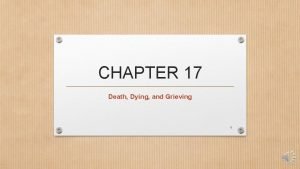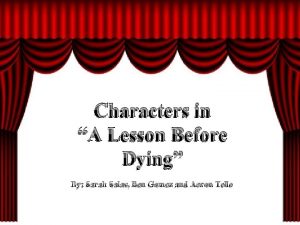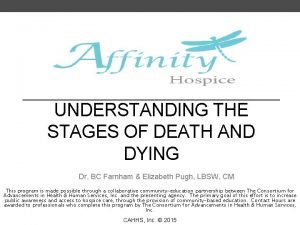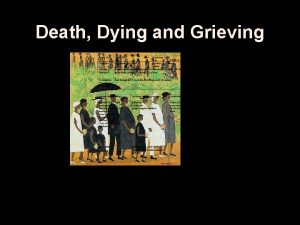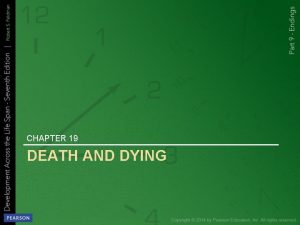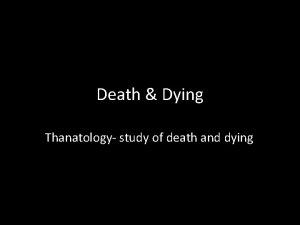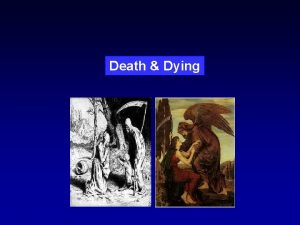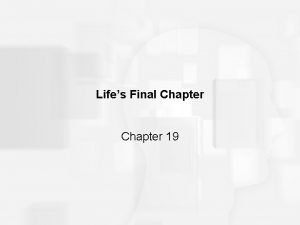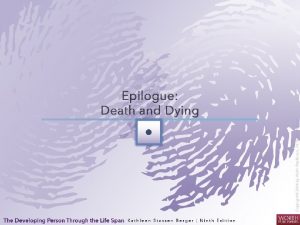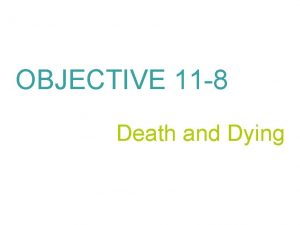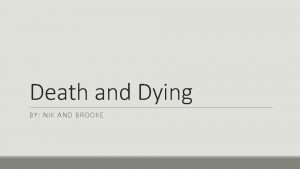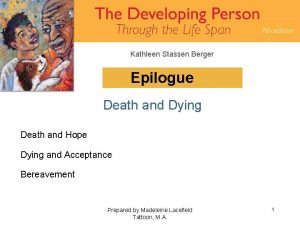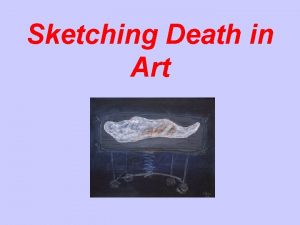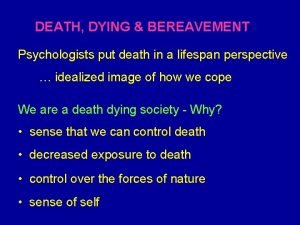CHAPTER 17 Death Dying and Grieving 1 LEARNING

















- Slides: 17

CHAPTER 17 Death, Dying, and Grieving 1

LEARNING GOALS 1. Evaluate issues in determining death and decisions regarding life, death, and health care. 2. Describe the roles of sociohistorical and cultural contexts in understanding death. 3. Explain the psychological aspects involved in facing one’s own death and the contexts in which people die. 4. Identify ways to cope with the death of another person. 2

Determining of Death • Brain death -- the neurological definition, when all electrical activity of the brain has ceased for a specified period • individual whose higher cortical areas have died may continue breathing and have a heartbeat • Natural Death Act and Advance Directive-legal definition: no life support to patients with no cortical function • A young woman was seriously injured in a car accident and now shows no higher cortical brain function. Her parents decide to take her off the lifesupport machines but are shocked when she continues to breathe on her own. Is the young woman dead? It is unclear, because death can be defined in different ways by different people. 3

Natural Death Act and Advance Directive • All 50 states now accept advance directives as reflecting an individual’s wishes • Living will -- document filed while the individual can still think clearly, which expresses the person’s desires regarding extraordinary medical procedures that may or may not be used to sustain life • advance directive • Purpose- A living will is a document that ensures the right of an individual to choose whether heroic measures will be used to sustain life. It permits an individual to decide how, when, and under what circumstances lifesustaining treatments will be used or withheld. 4

Euthanasia • Euthanasia -- painlessly ending lives of individuals who are suffering from an incurable disease or severe disability • mercy killing Two types: • active -- when death is deliberately induced • assisted suicide • passive -- when a person is allowed to die by withholding available treatment 5

Gentile, M. , & Fello, M. (1990) Criteria for admission: • completion of all active, curative treatment • patient’s awareness of diagnosis and prognosis • patient and family’s clear understanding of the goals of hospice care Hospice Typical composition of hospice team members • Hospice Nurse (coordinates care, principal support for patients and their families) • Hospice Aide (provides personal care and light housekeeping duties in the home) • Counselor (support for families, seeks out community resources, and helps with financial, legal, and insurance issues) • Therapists (physical, occupational, and speech therapists) • Nutritionist (counsels family members on the special nutritional needs of the patient) • Medical Director (directs symptom management for patient, educates patient and staff regarding the illness) • • Chaplain (attends to the spiritual needs of the patients and their families) Volunteers (friends and companions for patients, home care, office help, fundraising) 6

Changing Historical Circumstances • 200 years ago, many children and young adults died • average life expectancy was 47 years • In 1900, most people died at home, cared for by family • Today, death occurs most often among older adults • average life expectancy has increased to 78 • 80 percent of deaths occur in institutions and hospitals with professional caregivers 7

Cultural Variations • Individuals are more conscious of death in times of war, famine, and plague • Most societies have had philosophical or religious beliefs about death and most have a ritual that deals with death • In most societies, death is not viewed as the end of existence; the spirit is believed to live on 8

Elizabeth Kubler Ross Stages BRIEF DEFINTION/DESCRIPTION Denial and Isolation The dying person denies that she or he is going to die. Anger Feelings of anger, resentment, rage, and envy. Bargaining Person develops the hope that death can be postponed or delayed. One might try to negotiate with God for more time. Depression The person accepts the certainty of death and may spend time crying or grieving. Acceptance The person develops a sense of peace about their impending death. 9

Coping with Death and Loss • It is best for dying persons and their family members to know that death is immanent and a reality • individuals can close life with their own ideas about proper dying • they can complete some projects and plans and can make arrangements for funeral and for survivors • can reminisce • can experience physical sensations and medical procedures • Express your regard for the dying individual, don’t be afraid to express love 10

Dimension of Grief Approximately 80 -90% of survivors experience normal or uncomplicated grief reactions. Approximately 10 -20% of survivors experience complicated grief reactions. Grief -- emotional numbness, disbelief, separation anxiety, despair, sadness, and loneliness that accompany the loss of someone we love • Many dimensions • pining or yearning • separation anxiety • despair and sadness • hopelessness and defeat Prolonged Grief – Grief that involves enduring despair and is still unresolved over an extended period of time Disenfranchised grief describes an individual’s grief over a deceased person that is a socially ambiguous loss that can’t be openly mourned or supported Ex-spouse Abortion 11

Brown & Stoudemire’s Phases of Grief • Shock and disbelief • The time frame for this phase varies. • Preoccupation with the memory of the dead person • The time frame for this phase is approximately six months or longer • Resolution • This phase involves renewed interest in everyday activities. 12

Coping and Type of Death • Impact of death is strongly influenced by circumstances under which death occurs • Sudden, untimely, violent, or traumatic deaths are likely to have more intense and prolonged effects • Diverse grieving patterns are culturally embedded practices 13

Making Sense of the World • One beneficial aspect of grieving is that it stimulates many individuals to try to make sense of the world • When death is caused by accident or disaster, the effort to make sense of it is pursued vigorously • Bereaved want to put death in a perspective they can understand 14

Losing Life Partner • Those left behind by an intimate partner often prefer to suffer profound grief and often endure financial loss, loneliness, increased physical illness, and psychological disorders • Many widowers increase religious and spiritual beliefs following the loss of a spouse • Many widows are lonely • Bereaved are at higher risk for health problems • Social support helps them adjust to the death of a spouse 15

Forms of Mourning One decision is to decide what to do with the body • burial • cremation • Funeral services • more meaningful to religious survivors • Family and community have important roles 16

Sources: Brown, J. T. , & Stoudemire, A. (1983). Normal and pathological grief. Journal of the American Medical Association, 250, 378– 382 Gentile, M. , & Fello, M. (1990). Hospice care for the 1990 s: A concept coming of age. The Journal of Home Health Care Practice, 3, 1– 15. Thank you for watching Good luck with the exam 17
 An attitude that is helpful in hospice work is
An attitude that is helpful in hospice work is Chapter 13 - death and dying
Chapter 13 - death and dying What is the setting of the scarlet ibis
What is the setting of the scarlet ibis Nursing diagnosis for grieving
Nursing diagnosis for grieving One beneficial aspect of grieving is that it
One beneficial aspect of grieving is that it Forensic pathology examples
Forensic pathology examples Cuadro comparativo entre e-learning b-learning y m-learning
Cuadro comparativo entre e-learning b-learning y m-learning A lesson before dying chapter 22
A lesson before dying chapter 22 Characters from a lesson before dying
Characters from a lesson before dying Rebecca mark
Rebecca mark A lesson before dying vocabulary
A lesson before dying vocabulary Stages of dying
Stages of dying To an athlete dying young theme
To an athlete dying young theme The dying rooms
The dying rooms How to preserve a language
How to preserve a language Signs of dying from aspiration pneumonia
Signs of dying from aspiration pneumonia Thank you lord you died for me
Thank you lord you died for me Typical greek temple plan
Typical greek temple plan




